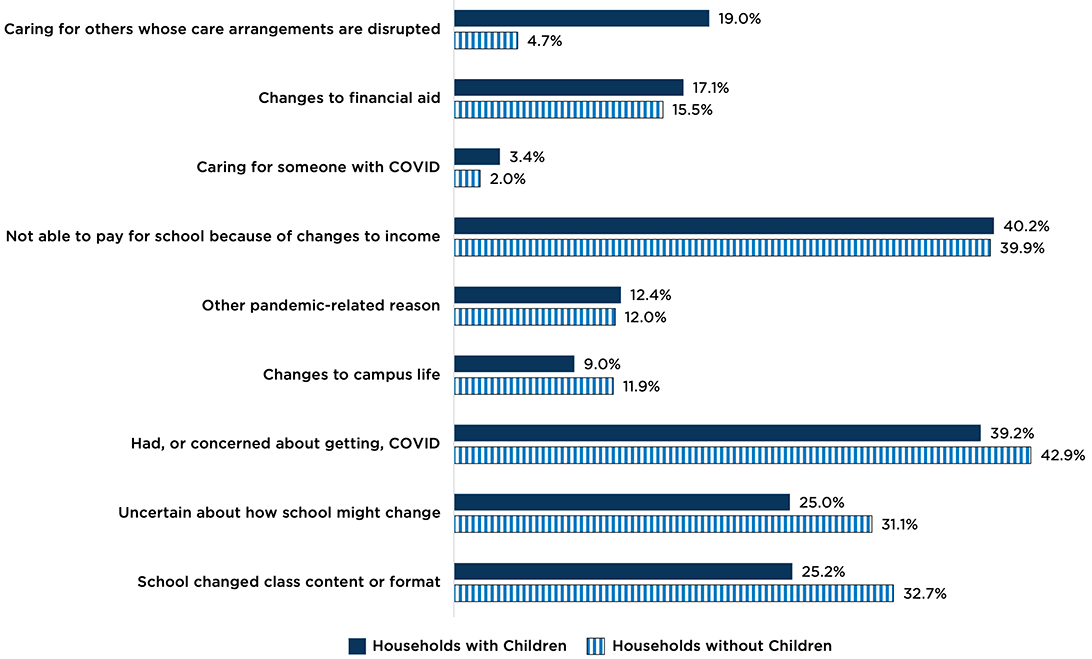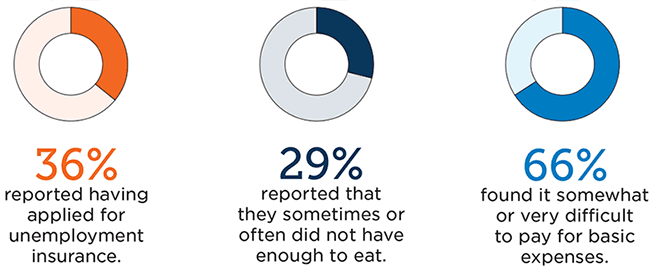COVID-19 Has Disrupted College Plans for Students in Households with Children
Authors
The COVID-19 pandemic has turned the nation’s college campuses upside down, and the brunt of this disruption has been borne by students with fewer resources or more responsibilities, including those caring for children and other family members. As colleges and universities grapple with how to support students with caregiving responsibilities through the pandemic and beyond, it is important for higher education leaders and policymakers to understand how these students are faring.
Students with caregiving responsibilities may include parenting students, students caring for siblings or other children, and students caring for elderly relatives or other adults in the household. Many of these students may face intergenerational caring responsibilities, in which child care needs and other caregiving responsibilities are both present. Students with caregiving responsibilities face multiple barriers to maintaining their higher education pathways, including time and financial pressures.
In this brief, we present findings on how students changed their education plans for the Fall 2020 semester. The analyses in this brief focus on students in households with children, especially those who have caregiving responsibilities. We also review relevant policy initiatives that have been implemented in response to the pandemic. Our findings are based on an analysis of a nationally representative sample of households from the U.S. Census Bureau’s Household Pulse Survey from August through December 2020.1
In the absence of child care for young children and in-person school for school-aged children, college students in households with children—particularly those with caregiving responsibilities—may not have time to complete their schoolwork or attend class themselves. Even before the pandemic, single mothers in college were strapped for time, spending an average of nine hours a day on housework and child care. News reports indicate that the pandemic has also forced more students attending or planning to attend higher education to take on caregiving responsibilities for younger siblings, often at the expense of their own educational plans. Higher education professionals have called attention to the needs of student caregivers—particularly low-income women of color, who must balance multiple responsibilities while they navigate the disproportionate effects of COVID-19 in their communities. Students with caregiving responsibilities need access to better supports in a higher education system that is designed primarily for students with the freedom to dedicate all of their time to schoolwork.
Key Findings
The COVID-19 pandemic has complicated college plans across the country. We first explore how plans have changed for all students; next, we turn to students in households with children, and finally to students in households with children in which the student changed plans due to caregiving responsibilities. (Keep in mind that, technically, our results are for households; however, to ease readability in this brief, we often refer to students as shorthand for the households in which they live.)
About three quarters of households in which at least one person planned to attend higher education in Fall 2020 responded that students needed to change their plans (76% of households with children and 75% of households without). More than one third of households (39% and 36%, respectively) responded that students cancelled their educational plans.
Households with children more often indicated that students had changed their higher education plans due to caregiving responsibilities, although their reasons for changing plans were otherwise similar to those in households without children.2 In nearly one in five (19%) households with children in which a student changed their Fall 2020 higher education plans, the student did so due to a need to care for others. In comparison, just 5 percent of households without children had a student change plans due to caregiving responsibilities. This suggests that, in households with children, students could be taking on significant caregiving roles in their homes and may need support to maintain their higher education paths.
Figure 1: Reasons for change among households with members who planned to attend higher education and whose plans changed, by presence of children

Source: Child Trends analysis of the U.S. Census Bureau’s Household Pulse Survey, August-December 2020
Households with children in which a student changed their higher education plans in Fall 2020 due to caregiving responsibilities have also struggled financially during the pandemic, with regard to both continuing their education plans and meeting their basic needs. Large proportions of households with children in which a student changed their higher education plans due to caregiving responsibilities also changed their plans due to financial constraints. Fifty-three (53) percent reported that the student also changed their plans because they were unable to pay for tuition due to pandemic-related changes in income. Financial aid posed an additional challenge for 19 percent of these households, in which students also changed their plans because of changes to financial aid.
Households with children in which students changed plans due to caregiving responsibilities also experienced financial constraints outside of their higher education plans. Thirty-six (36) percent of these households reported that someone in the household applied for unemployment insurance. Twenty-nine (29) percent reported that they sometimes or often did not have enough to eat, and 66 percent found it somewhat or very difficult to pay for basic expenses.
Figure 2: Households with children in which students changed plans due to caregiving responsibilities experienced financial constraints outside of their higher education plans

Source: Child Trends analysis of the U.S. Census Bureau’s Household Pulse Survey, August-December 2020
Discussion
The pandemic has served as a reminder that many students balance caregiving, employment, and financial responsibilities with their studies, and the above analyses highlight the precarity of the higher education system for these students during the COVID-19 pandemic. Our findings on the challenges that these students have faced during the pandemic parallel those found by other researchers, including the Community College Research Center’s work examining community college students using Census Pulse data, a nationally representative survey of students conducted by Lumina Foundation and Gallup, and the Hope Center for College, Community, and Justice’s survey of students at more than 200 colleges.
The devastating impacts of COVID-19 on caregiving college students highlight the importance of bolstering relief and student support services to the students who need them most, including those caring for younger siblings or other family members and those who are parenting. Although we do not know the total number of students with caregiving responsibilities, we expect that it is substantial, as more than one fifth of all college students are parents. Access to services such as on-campus child care and flexible schedules was rare before the pandemic, and has only become more important. Despite having higher grades than their peers without children, on average, parenting students were almost twice as likely to leave college without completing a degree than their peers without children—even before the pandemic—and changes to academic plans in the past year could worsen the situation. Policies that provide financial relief for students and support institutions’ abilities to support them could help minimize the impact on students who changed their plans to provide care, and provide critical support to the low-income students and students of color who are disproportionately taking on these responsibilities.
Fortunately, some recent federal policy interventions that target supports to low-income students may also help support students caring for others, at least during COVID-19 and its immediate aftermath. Eligibility for the Supplemental Nutrition Assistance Program (SNAP) has been expanded to more college students during the COVID-19 crisis, and recent guidance from the U.S. Department of Education supports colleges conducting direct outreach to students who may now be eligible. Colleges can use their Higher Education Emergency Relief Fund (HEERF) grants to subsidize child care for parenting students. Additional initiatives aimed at low-income families in the American Rescue Plan will also likely benefit caregiving students, including increased unemployment assistance, rental assistance, and increased child tax credits.
While these temporary efforts are encouraging, the negative effects of the pandemic on students’ higher education careers will be felt for years to come, and more work is needed to ensure that caregiving students have the supports they need in the future. Reauthorizing the Higher Education Act is one vehicle for ensuring long-term support, and recent proposals have included provisions to strengthen campus-based child care and emergency grants for students experiencing sudden financial hardship. Policymakers should target reforms to institutions that parenting students often attend, such as community colleges.
To emerge from this pandemic with a stronger, more equitable higher education system than before, we will need to address the everyday challenges that keep many students from completing their higher education plans—particularly those who are also managing the well-being, care, and education of children in their homes.
Notes
© Copyright 2024 ChildTrendsPrivacy Statement
Newsletter SignupLinkedInThreadsYouTube